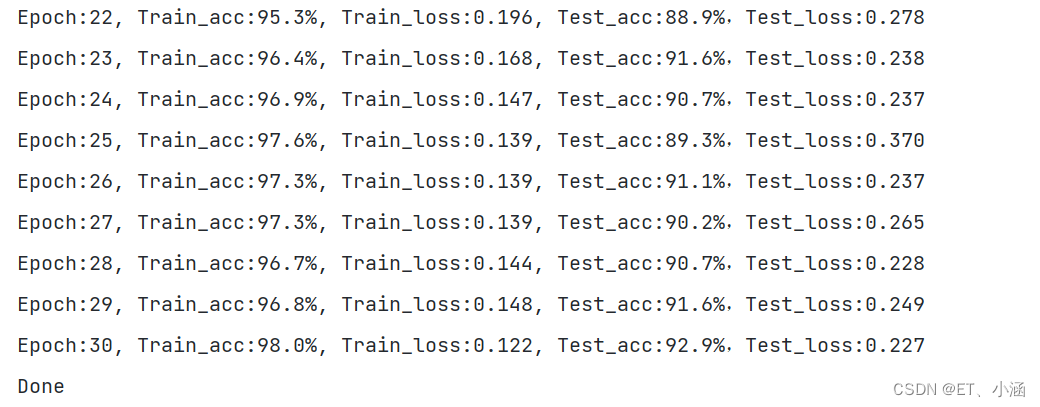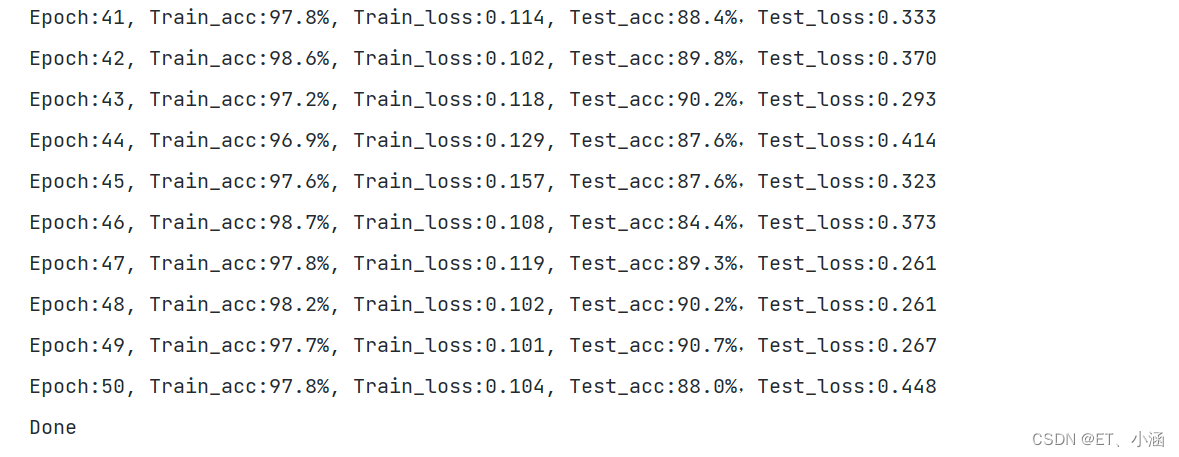文章目录
深度学习Week3——天气识别
一、前言
二、我的环境
三、前期工作
1、配置环境
2、导入数据
3、划分数据集
四、构建CNN网络
五、训练模型
1、设置超参数
2、编写训练函数
3、编写测试函数
六、结果可视化
七、拔高训练
八、碎碎念
一、前言
- 🍨 本文为🔗365天深度学习训练营 中的学习记录博客
- 🍖 原作者:K同学啊 | 接辅导、项目定制
有了前两周的学习,本周内容相对较简单,不过从本周开始,我们的数据集不再使用dataset下载,而是由K同学提供的网盘链接下载到本地,然后从本地当中读取。
同时由于我的设备没有GPU,因此直接使用device = torch.device("cpu")
二、我的环境
- 电脑系统:Windows 10
- 语言环境:Python 3.11.3
- 编译器:Pycharm2023.2.3
深度学习环境:Pytorch
显卡及显存:无
三、前期工作
1、导入库并配置环境
import torch
import torch.nn as nn
import torchvision.transforms as transforms
import torchvision
from torchvision import transforms, datasets
import os,PIL,pathlib,random
import numpy as np
device = torch.device("cpu")
device
输出:
device(type='cpu')
至此,我们的环境已经配置完成。
2、 导入数据
我们下载好文件到自己的文件夹目录中,复制文件地址备用。
data_dir = "E:\DeepLearning\Data_\第5天-没有加密版本\第5天\weather_photos"
data_dir = pathlib.Path(data_dir)
data_paths = list(data_dir.glob('*'))
classeNames = [str(path).split("\\")[6] for path in data_paths]
classeNames
输出:
['cloudy', 'rain', 'shine', 'sunrise']
data_dir = "E:\DeepLearning\Data_\第5天-没有加密版本\第5天\weather_photos"
data_dir = pathlib.Path(data_dir)
image_count = len(list(data_dir.glob('*/*.jpg')))
print("图片总数为:",image_count)
输出:
图片总数为: 1125
然后我们可以指定一张光照的照片作为测试是否导入数据成功。
roses = list(data_dir.glob('shine/*.jpg'))
PIL.Image.open(str(roses[0]))
输出:

可以看出导入成功!
from matplotlib import pyplot as plt
# 指定图像文件夹路径
image_folder = "E:\DeepLearning\Data_\第5天-没有加密版本\第5天\weather_photos\sunrise"
# 获取文件夹中的所有图像文件
image_files = [f for f in os.listdir(image_folder) if f.endswith((".jpg", ".png", ".jpeg"))]
# 创建Matplotlib图像
fig, axes = plt.subplots(3, 8, figsize=(16, 6))
# 使用列表推导式加载和显示图像
for ax, img_file in zip(axes.flat, image_files):
img_path = os.path.join(image_folder, img_file)
img = PIT.Image.open(img_path)
ax.imshow(img)
ax.axis('off')
# 显示图像
plt.tight_layout()
plt

total_datadir = "E:\DeepLearning\Data_\第5天-没有加密版本\第5天\weather_photos"
# 关于transforms.Compose的更多介绍可以参考:https://blog.csdn.net/qq_38251616/article/details/124878863
train_transforms = transforms.Compose([
transforms.Resize([224, 224]), # 将输入图片resize成统一尺寸
transforms.ToTensor(), # 将PIL Image或numpy.ndarray转换为tensor,并归一化到[0,1]之间
transforms.Normalize( # 标准化处理-->转换为标准正太分布(高斯分布),使模型更容易收敛
mean=[0.485, 0.456, 0.406],
std=[0.229, 0.224, 0.225]) # 其中 mean=[0.485,0.456,0.406]与std=[0.229,0.224,0.225] 从数据集中随机抽样计算得到的。
])
total_data = datasets.ImageFolder(total_datadir,transform=train_transforms)
total_data
输出:
Dataset ImageFolder
Number of datapoints: 1125
Root location: E:\DeepLearning\Data_\第5天-没有加密版本\第5天\weather_photos
StandardTransform
Transform: Compose(
Resize(size=[224, 224], interpolation=bilinear, max_size=None, antialias=warn)
ToTensor()
Normalize(mean=[0.485, 0.456, 0.406], std=[0.229, 0.224, 0.225])
)
3、划分训练集
- train_size表示训练集大小,通过将总体数据长度的80%转换为整数得到;
- test_size表示测试集大小,是总体数据长度减去训练集大小。
而使用torch.utils.data.random_split()方法进行数据集划分。该方法将总体数据total_data按照指定的大小比例([train_size, test_size])随机划分为训练集和测试集,并将划分结果分别赋值给train_dataset和test_dataset两个变量。
train_size = int(0.8 * len(total_data))
test_size = len(total_data) - train_size
train_dataset, test_dataset = torch.utils.data.random_split(total_data, [train_size, test_size])
train_dataset, test_dataset
结果:
(<torch.utils.data.dataset.Subset at 0x27cd1a2a950>,
<torch.utils.data.dataset.Subset at 0x27ccf319350>)
train_size,test_size
(900, 225)
batch_size = 32
train_dl = torch.utils.data.DataLoader(train_dataset,
batch_size=batch_size,
shuffle=True,
num_workers=1)
test_dl = torch.utils.data.DataLoader(test_dataset,
batch_size=batch_size,
shuffle=True,
num_workers=1)
for X, y in test_dl:
print("Shape of X [N, C, H, W]: ", X.shape)
print("Shape of y: ", y.shape, y.dtype)
break
输出:
Shape of X [N, C, H, W]: torch.Size([32, 3, 224, 224])
Shape of y: torch.Size([32]) torch.int64
四 、构建简单的CNN网络
nn.Conv2d()函数:
第一个参数(in_channels)是输入的channel数量
第二个参数(out_channels)是输出的channel数量
第三个参数(kernel_size)是卷积核大小
第四个参数(stride)和第五个参数(padding)分别是步长和填充大小,默认为1和0,一般可省略。
import torch.nn.functional as F
class Network_bn(nn.Module):
def __init__(self):
super(Network_bn, self).__init__()
self.conv1 = nn.Conv2d(in_channels=3, out_channels=12, kernel_size=5, stride=1, padding=0)
self.bn1 = nn.BatchNorm2d(12)
self.conv2 = nn.Conv2d(in_channels=12, out_channels=12, kernel_size=5, stride=1, padding=0)
self.bn2 = nn.BatchNorm2d(12)
self.pool = nn.MaxPool2d(2,2)
self.conv4 = nn.Conv2d(in_channels=12, out_channels=24, kernel_size=5, stride=1, padding=0)
self.bn4 = nn.BatchNorm2d(24)
self.conv5 = nn.Conv2d(in_channels=24, out_channels=24, kernel_size=5, stride=1, padding=0)
self.bn5 = nn.BatchNorm2d(24)
self.fc1 = nn.Linear(24*50*50, len(classeNames))
def forward(self, x):
x = F.relu(self.bn1(self.conv1(x)))
x = F.relu(self.bn2(self.conv2(x)))
x = self.pool(x)
x = F.relu(self.bn4(self.conv4(x)))
x = F.relu(self.bn5(self.conv5(x)))
x = self.pool(x)
x = x.view(-1, 24*50*50)
x = self.fc1(x)
return x
model = Network_bn().to(device)
model
输出:
Network_bn(
(conv1): Conv2d(3, 12, kernel_size=(5, 5), stride=(1, 1))
(bn1): BatchNorm2d(12, eps=1e-05, momentum=0.1, affine=True, track_running_stats=True)
(conv2): Conv2d(12, 12, kernel_size=(5, 5), stride=(1, 1))
(bn2): BatchNorm2d(12, eps=1e-05, momentum=0.1, affine=True, track_running_stats=True)
(pool): MaxPool2d(kernel_size=2, stride=2, padding=0, dilation=1, ceil_mode=False)
(conv4): Conv2d(12, 24, kernel_size=(5, 5), stride=(1, 1))
(bn4): BatchNorm2d(24, eps=1e-05, momentum=0.1, affine=True, track_running_stats=True)
(conv5): Conv2d(24, 24, kernel_size=(5, 5), stride=(1, 1))
(bn5): BatchNorm2d(24, eps=1e-05, momentum=0.1, affine=True, track_running_stats=True)
(fc1): Linear(in_features=60000, out_features=3, bias=True)
)
五、训练模型
1、设置超参数
loss_fn = nn.CrossEntropyLoss() # 创建损失函数
learn_rate = 1e-4 # 学习率
opt = torch.optim.SGD(model.parameters(),lr=learn_rate)
2、编写训练函数
其核心思想是在每个训练迭代中,它从数据加载器中获取一个小批量的训练数据(包含图像和标签),将数据传递给模型进行前向传播,计算损失,然后通过反向传播更新模型的参数。最后,它记录并返回训练的准确率和损失。
简要概括:
- 从数据加载器中获取小批量训练数据。
- 将数据传递给模型进行前向传播,计算预测值。
- 计算预测值与真实标签之间的损失。
- 使用反向传播更新模型参数。
- 记录并返回训练准确率和损失。
# 训练循环
def train(dataloader, model, loss_fn, optimizer):
size = len(dataloader.dataset) # 训练集的大小,一共60000张图片
num_batches = len(dataloader) # 批次数目,1875(60000/32)
train_loss, train_acc = 0, 0 # 初始化训练损失和正确率
for X, y in dataloader: # 获取图片及其标签
X, y = X.to(device), y.to(device)
# 计算预测误差
pred = model(X) # 网络输出
loss = loss_fn(pred, y) # 计算网络输出和真实值之间的差距,targets为真实值,计算二者差值即为损失
# 反向传播
optimizer.zero_grad() # grad属性归零
loss.backward() # 反向传播
optimizer.step() # 每一步自动更新
# 记录acc与loss
train_acc += (pred.argmax(1) == y).type(torch.float).sum().item()
train_loss += loss.item()
train_acc /= size
train_loss /= num_batches
return train_acc, train_loss
3、编写测试函数
下面这段代码主要是用于测试(评估)深度学习模型性能的函数。在每个测试迭代中,它从测试数据加载器中获取一个小批量的数据(包含图像和标签),通过模型进行前向传播,计算损失,然后记录测试准确率和损失。
简要概括:
- 从测试数据加载器中获取小批量测试数据。
- 将数据传递给模型进行前向传播,得到预测值。
- 计算预测值与真实标签之间的损失。
- 记录并返回测试准确率和损失。
测试函数和训练函数大致相同,但是由于不进行梯度下降对网络权重进行更新,所以不需要传入优化器
def test (dataloader, model, loss_fn):
size = len(dataloader.dataset) # 测试集的大小,一共10000张图片
num_batches = len(dataloader) # 批次数目,313(10000/32=312.5,向上取整)
test_loss, test_acc = 0, 0
# 当不进行训练时,停止梯度更新,节省计算内存消耗
with torch.no_grad():
for imgs, target in dataloader:
imgs, target = imgs.to(device), target.to(device)
# 计算loss
target_pred = model(imgs)
loss = loss_fn(target_pred, target)
test_loss += loss.item()
test_acc += (target_pred.argmax(1) == target).type(torch.float).sum().item()
test_acc /= size
test_loss /= num_batches
return test_acc, test_loss
4、正式训练
主要是一个简单的训练循环,用于训练和评估深度学习模型多个epochs。在每个epoch中,它分别进行训练和测试,并记录训练集和测试集的准确率以及损失。最后,将每个epoch的结果打印出来。
epochs = 20
train_loss = []
train_acc = []
test_loss = []
test_acc = []
for epoch in range(epochs):
model.train()
epoch_train_acc, epoch_train_loss = train(train_dl, model, loss_fn, opt)
model.eval()
epoch_test_acc, epoch_test_loss = test(test_dl, model, loss_fn)
train_acc.append(epoch_train_acc)
train_loss.append(epoch_train_loss)
test_acc.append(epochtest_acc)
test_loss.append(epoch_test_loss)
template = ('Epoch:{:2d}, Train_acc:{:.1f}%, Train_loss:{:.3f}, Test_acc:{:.1f}%,Test_loss:{:.3f}')
print(template.format(epoch+1, epoch_train_acc*100, epoch_train_loss, epoch_test_acc*100, epoch_test_loss))
print('Done')
输出:
Epoch: 1, Train_acc:89.4%, Train_loss:0.356, Test_acc:88.9%,Test_loss:0.316
Epoch: 2, Train_acc:91.0%, Train_loss:0.330, Test_acc:88.4%,Test_loss:0.328
Epoch: 3, Train_acc:91.6%, Train_loss:0.324, Test_acc:90.2%,Test_loss:0.493
Epoch: 4, Train_acc:90.9%, Train_loss:0.330, Test_acc:87.6%,Test_loss:0.775
Epoch: 5, Train_acc:92.1%, Train_loss:0.280, Test_acc:92.0%,Test_loss:0.272
Epoch: 6, Train_acc:92.3%, Train_loss:0.272, Test_acc:91.6%,Test_loss:0.267
Epoch: 7, Train_acc:92.2%, Train_loss:0.302, Test_acc:90.2%,Test_loss:0.280
Epoch: 8, Train_acc:93.0%, Train_loss:0.263, Test_acc:91.1%,Test_loss:0.312
Epoch: 9, Train_acc:93.2%, Train_loss:0.247, Test_acc:90.7%,Test_loss:0.387
Epoch:10, Train_acc:94.2%, Train_loss:0.251, Test_acc:90.7%,Test_loss:0.274
Epoch:11, Train_acc:94.4%, Train_loss:0.230, Test_acc:89.3%,Test_loss:0.273
Epoch:12, Train_acc:93.7%, Train_loss:0.245, Test_acc:91.6%,Test_loss:0.316
Epoch:13, Train_acc:94.6%, Train_loss:0.216, Test_acc:92.0%,Test_loss:0.237
Epoch:14, Train_acc:95.0%, Train_loss:0.229, Test_acc:92.0%,Test_loss:0.237
Epoch:15, Train_acc:96.0%, Train_loss:0.188, Test_acc:92.0%,Test_loss:0.230
Epoch:16, Train_acc:95.7%, Train_loss:0.180, Test_acc:92.4%,Test_loss:0.225
Epoch:17, Train_acc:96.3%, Train_loss:0.175, Test_acc:91.1%,Test_loss:0.266
Epoch:18, Train_acc:95.4%, Train_loss:0.186, Test_acc:92.4%,Test_loss:0.221
Epoch:19, Train_acc:96.4%, Train_loss:0.158, Test_acc:92.0%,Test_loss:0.217
Epoch:20, Train_acc:97.0%, Train_loss:0.143, Test_acc:92.4%,Test_loss:0.215
Done
六、结果可视化
import matplotlib.pyplot as plt
#隐藏警告
import warnings
warnings.filterwarnings("ignore") #忽略警告信息
plt.rcParams['font.sans-serif'] = ['SimHei'] # 用来正常显示中文标签
plt.rcParams['axes.unicode_minus'] = False # 用来正常显示负号
plt.rcParams['figure.dpi'] = 100 #分辨率
epochs_range = range(epochs)
plt.figure(figsize=(12, 3))
plt.subplot(1, 2, 1)
plt.plot(epochs_range, train_acc, label='Training Accuracy')
plt.plot(epochs_range, test_acc, label='Test Accuracy')
plt.legend(loc='lower right')
plt.title('Training and Validation Accuracy')
plt.subplot(1, 2, 2)
plt.plot(epochs_range, train_loss, label='Training Loss')
plt.plot(epochs_range, test_loss, label='Test Loss')
plt.legend(loc='upper right')
plt.title('Training and Validation Loss')
plt # 因为我是用的Jupyter,因此不用plt.show()
结果:
从图中我们可以看出训练和测试准确性都随着时间的推移而增加,训练和测试损失都随着时间的推移而减少,说明我们本周构建的模型表现良好,但可能存在轻微的过拟合以及噪声,因为从图中明显能看见几个凸起和凹陷。
七、拔高训练—提高测试集accuracy
1. 我们可以通过增加训练epoch的方法来提高训练集accuracy**
1.1 首先是epoch值为30的情况:


1.2 然后是epoch值为50的情况:


很明显,测试集accuracy得到了提高!





















 729
729











 被折叠的 条评论
为什么被折叠?
被折叠的 条评论
为什么被折叠?








